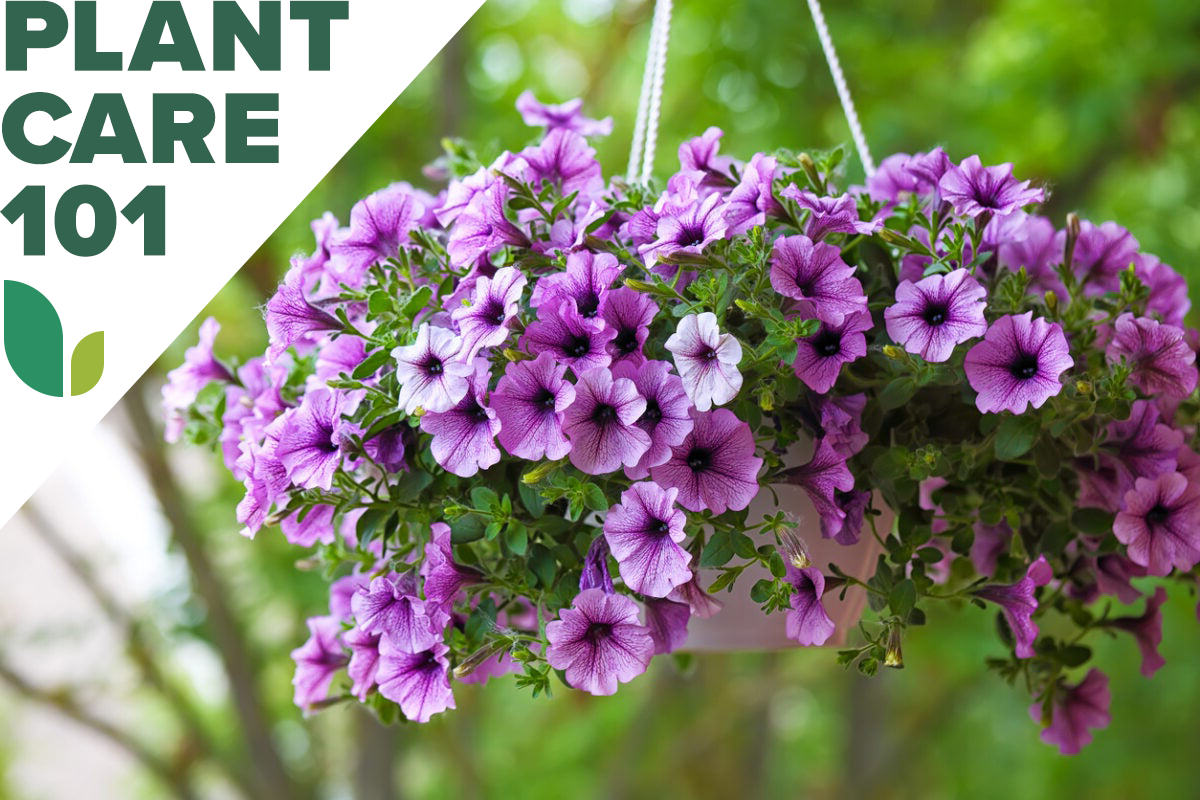

We may earn revenue from the products available on this page and participate in affiliate programs. Learn More ›
Petunias may just be the teacher’s pets of the plant world. They work hard at blooming and almost always look good. They don’t demand constant attention, either, making petunia care relatively easy. What other annuals can compete with that?
Actually, though, the “pet” in this South American flower’s name originally derived from petun, which means “worthless tobacco” in one of Brazil’s indigenous Tupian languages. So, petunias (which are, indeed, related to tobacco) had to prove themselves, becoming a blooming success story! According to a 2020 USDA survey, they were the most popular bedding annual in the United States at the time.
RELATED: 14 Old-Fashioned Flowers That Still Look Great in Today’s Home Gardens
Growing Petunias at a Glance
Common Name: Petunia
Scientific Name: Petunia spp.
Hardiness Zone: USDA Zones 10 and 11
Soil: Well-draining, pH 6 to 7
Light: Full sun
Water: Medium
Food: Balanced or bloom-booster fertilizer
Propagation: Seed
Safety: Nontoxic
Petunia Characteristics
A petunia plant usually doesn’t grow taller than 2 feet, but the most vigorous spreading types can reach 4 feet wide. The often fragrant, funnel-shaped petunia flower ranges in size from 1 inch to 6 inches and the colors of petunias cover almost the full spectrum of hues, including orange, green, and black. Those blooms can be double, ruffled, heavily veined, picotee (solid color with edges of a different color), or even spattered with “stars.” On the other hand, petunia foliage isn’t showy, but it is soft and a bit sticky.
While petunias are technically tender perennials and can be hardy in USDA Zones 10 and 11, most people grow them as summer annuals. The sizzling summers in Zones 12 and 13 (Hawaii, Puerto Rico, and Guam) might kill them, though, so they should be raised during winter or spring there. In frost-free parts of Florida and other Southern states, meanwhile, petunias can thrive during those seasons.
Recommended Petunia Varieties
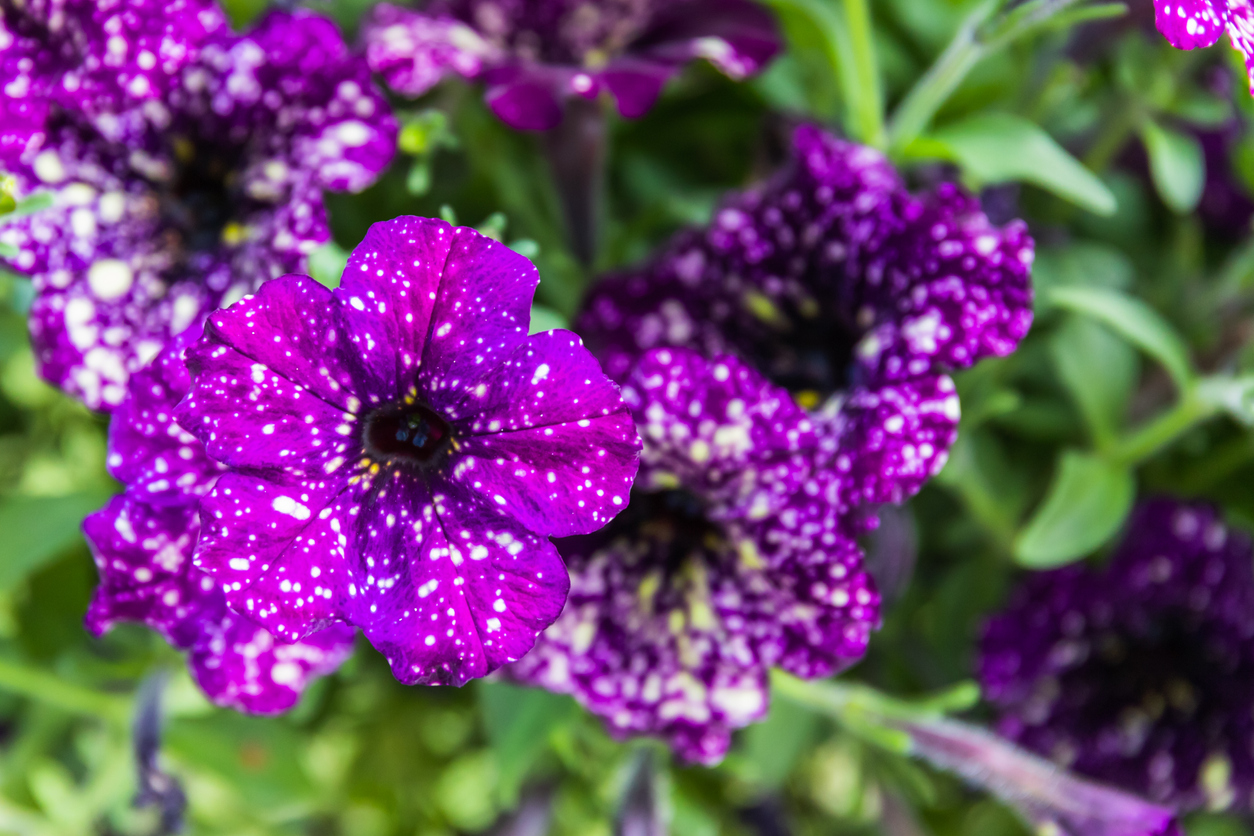
Below are some general petunia types you can grow in your garden. However, note that some newer cultivars, such as bubblegum petunias, don’t fit neatly into any of these categories, since that pink variety creeps like the spreading type but also can grow 2 feet tall, more like a grandiflora.
- Grandiflora: This category, which includes the popular Daddy petunia series, produces the largest flowers—usually 3 to 4 inches across but sometimes attaining 5 or 6 inches—on plants that may reach 15 inches or so in height.
- Multiflora: Named for the number of their blooms, multiflora plants such as the Carpet petunia series generally produce more flowers than grandiflora types do, but smaller ones—about 2 inches in diameter—on 1-foot plants.
- Floribunda: Modern cultivars of multiflora petunias, the floribunda variety include the Madness series and have slightly larger blooms than multifloras—usually about 3 inches across—but are similarly prolific in flowering.
- Milliflora: This “miniature” petunia category includes plants that might not grow taller than 10 inches with 1- to 1½-inch blooms, such as those in the Fantasy series.
- Creeping or trailing: Creeping or trailing petunias such as the Wave petunia series grow to only 6 inches or so in height, but a single plant can cover 3 or 4 feet of ground, producing multitudes of 2-inch blooms.
RELATED: 32 Inspiring Flower Bed Ideas for Yards of Any Size
Planting Petunias
Planting petunias is pretty straightforward, as is petunia care. They grow well in garden beds or containers. If you wish to start your petunias from seed indoors, plan to do so at least 2 months before you intend to plant them outdoors.
When is the best time to plant petunias?
Set out petunias in spring after your last frost date, when the temperature of the soil has warmed to at least 60 degrees Fahrenheit. Plants that have been growing under lights or in a greenhouse should be exposed gradually to outdoor conditions before being placed in the ground.
Where can petunias grow?
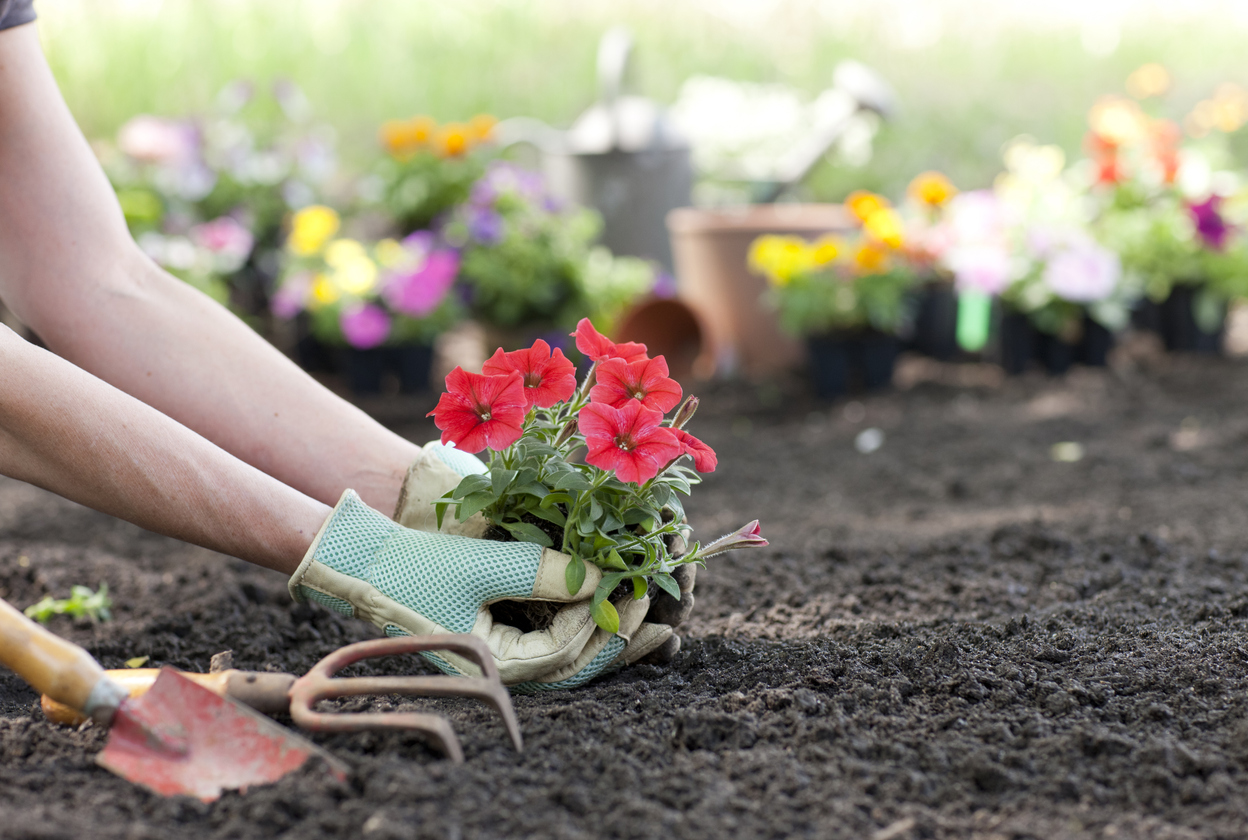
Choose a location in full sun and protected from the wind. This spot should also have at least moderately fertile, well-draining soil with a pH of 6 to 7. Although petunias can survive in partial shade, they won’t bloom as well in those conditions. For soil that lacks nutrients or is too heavy, work in a couple of inches of compost first to improve both drainage and fertility.
How do you plant petunias?
Petunias tend to be most fragrant at night, so it’s a good idea to plant them where you can enjoy their fragrance on summer evenings. Follow these steps when planting petunias outdoors:
- Water petunias before removing them from their containers.
- After easing them out of their pots or packs, separate any roots that are growing too tightly together.
- Dig holes and set the plants in the ground at the same level at which they grew previously, spacing them 18 inches apart for spreading types, 12 inches apart for grandiflora and multiflora types, and 6 inches apart for milliflora types.
Can you grow petunias in containers?
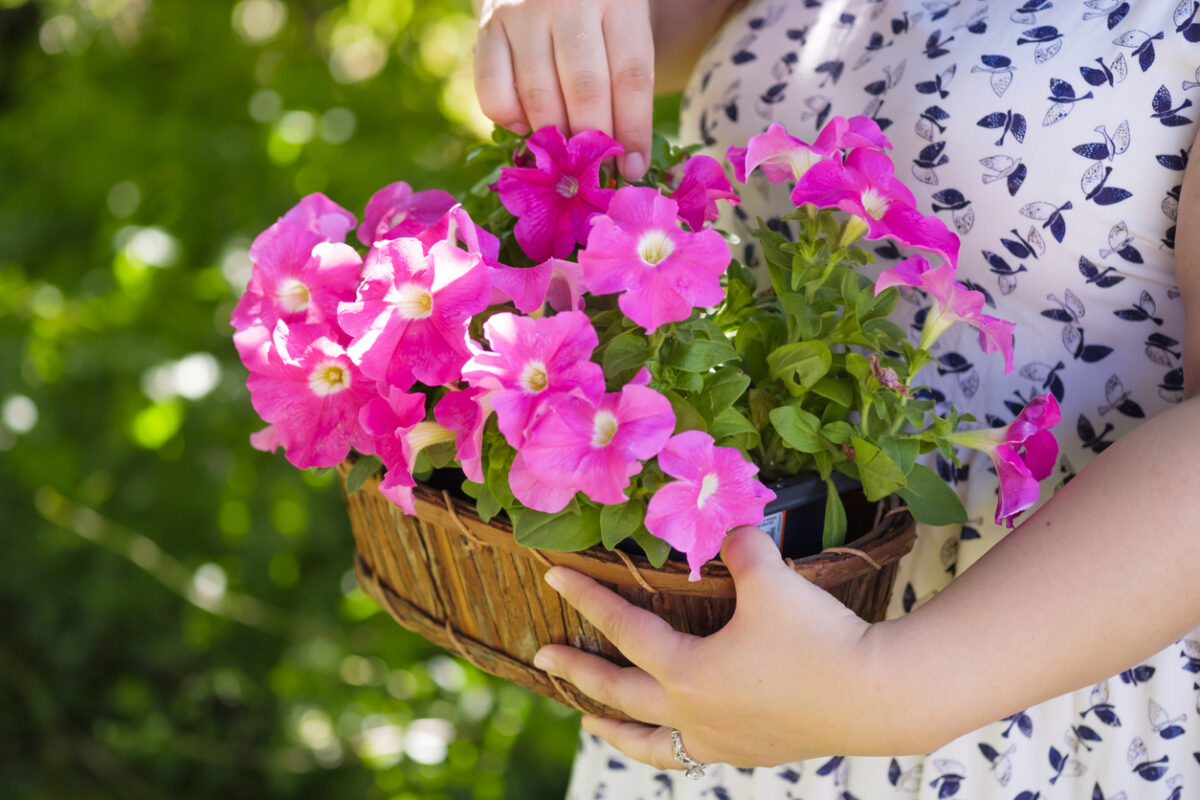
Petunias thrive as hanging basket flowers, window box plants, or full-sun container stars. You can group them a bit more closely in containers than in the ground, using one plant for each 6 inches of a pot’s diameter. For example, two petunias fit in a 12-inch container, three in an 18-inch pot, etc. However, because of their smaller size, millifloras can grow even closer together than this formula suggests.
RELATED: Late Bloomers: 25 Summer Flowers to Keep Color in Your Garden
Watering Petunias
Petunias need about an inch of water per week from rain or irrigation. Avoid watering them from overhead since their large flowers can be damaged both by heavy rainfall or streams of water poured from above. Instead, use drip irrigation or a watering can with its spout inserted beneath their foliage.
Closely planted petunias in hanging baskets might need water as often as once per day during hot weather. However, make sure that their containers have drainage holes to allow any excess to run off.
Fertilizing Petunias
Before planting petunias in the ground, work a balanced or bloom booster fertilizer into the soil. For a 10-10-10 type, for example, you’ll need about 1 pound of fertilizer per 100 square feet, and at least twice that amount for an organic 5-5-5 variety.
Fertilize petunias in containers with a water-soluble bloom-booster plant food, in which the center (phosphorus) number is larger than the others, applying it once a week for the spreading variety and once every 2 weeks for other types.
Pruning Petunias
When grandiflora and multiflora plants reach a height of 6 inches, pinch off their tips to encourage them to branch out. Millifloras and spreading types generally don’t require pinching.
Deadheading will keep these long-lasting flowers blooming all summer rather than turning seedy in more ways than one! Learning how to deadhead petunias isn’t complicated. Simply remove all the withered blooms by pinching them off just below their calyxes. If flowering falters in midsummer, cut the plants back by half. That should encourage them to make new growth and new blooms.
RELATED: The Dos and Don’ts of Deadheading Flowers
Propagating Petunias
Because petunia seeds are very fine, sowing them is easier if you purchase the pelleted type. Press the seeds—pelleted or not—into the surface of damp and sterile seed starting mix, but don’t cover them. Place their container beneath a fluorescent light fixture (either a grow light or shop light) in a location where the temperature remains between 70 and 75 degrees Fahrenheit.
If you keep the bulbs lit for 16 hours per day, the seeds should sprout within a week to 10 days. Because they are so tiny, the seedlings might be hard to see at first.
Safety Considerations
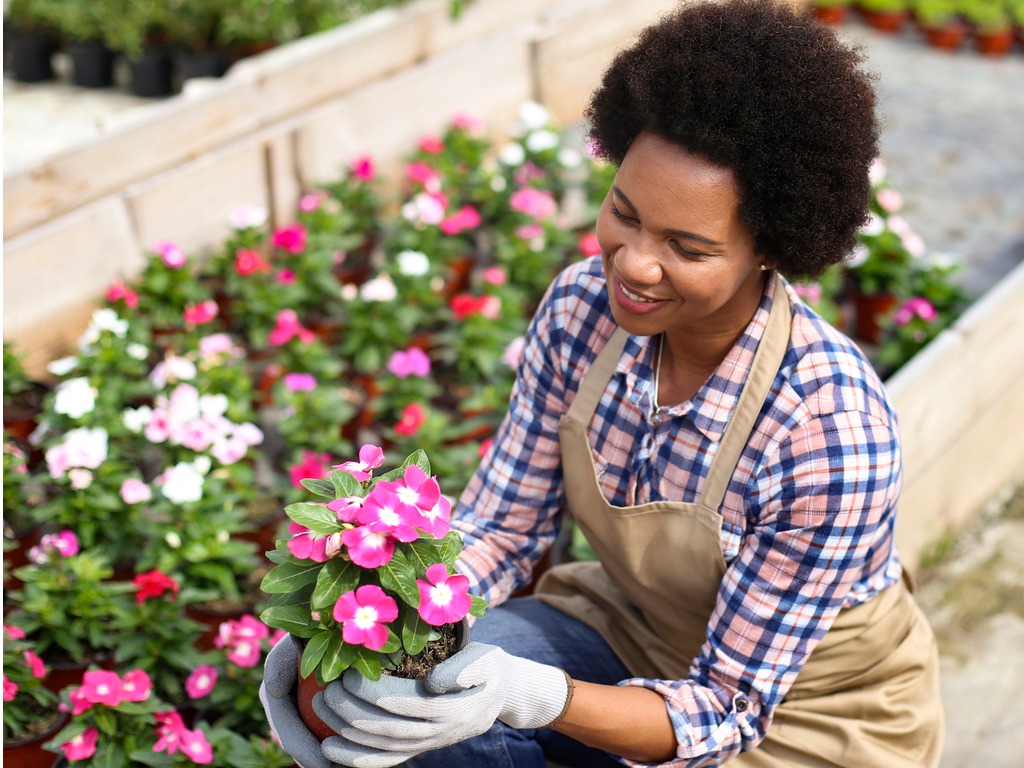
Petunias are considered nontoxic to pets and humans. However, they do contain enough toxins to kill some insects, with the flowers actually dispatching those pests faster than the foliage does, so it isn’t a good idea to eat either!
Petunia flowers also can be highly fragrant, especially at night, with old-fashioned varieties and white or lavender types reportedly exuding the most scent. Although most people find the fragrance pleasant, it could be irritating to those who are sensitive to perfumes.
Potential Pests and Diseases
The large blooms of some grandiflora petunia types tend to rot in overly wet or overly hot and humid climates, often due to the botrytis fungus, which can infect the flowers with gray mold. Gardeners in such regions might want to look for a weather-resistant petunia series, such as Storm and Daddy, or grow smaller-flowered cultivars instead.
Petunias are usually not bothered much by insects—perhaps due to their blooms and leaves’ built-in “pesticide”—but they do suffer from slug damage. To combat slugs, scatter iron phosphate pellets around the plants at the rate of about a teaspoon per square yard.
Looking for more beginner-friendly flowering annuals? Check out our guides on growing dahlias, geraniums, and zinnias.
